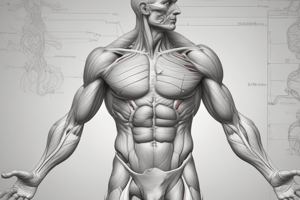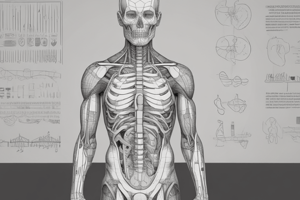Podcast
Questions and Answers
What are the three main muscle types?
What are the three main muscle types?
- Skeletal, Cardiac, Smooth
- Cardiac, Flexor, Extensor
- Smooth, Striated, Flexor
- Cardiac, Smooth, Striated (correct)
Skeletal muscles are attached to bones.
Skeletal muscles are attached to bones.
True (A)
Smooth muscle is responsible for voluntary movement.
Smooth muscle is responsible for voluntary movement.
False (B)
Cardiac muscle is found only in the heart.
Cardiac muscle is found only in the heart.
Striated muscle is also known as striped or skeletal muscle.
Striated muscle is also known as striped or skeletal muscle.
Striated muscle is known for its high endurance.
Striated muscle is known for its high endurance.
Cardiac muscle has a high endurance capacity.
Cardiac muscle has a high endurance capacity.
Smooth muscle is a high endurance muscle type.
Smooth muscle is a high endurance muscle type.
What is the functional unit of skeletal muscle?
What is the functional unit of skeletal muscle?
The number of muscle fibres per motor unit is the same for all muscles.
The number of muscle fibres per motor unit is the same for all muscles.
What is the neuromuscular junction (NMJ)?
What is the neuromuscular junction (NMJ)?
Muscle fibres contract in an "all-or-nothing" manner at the NMJ.
Muscle fibres contract in an "all-or-nothing" manner at the NMJ.
The degree of whole muscle contraction is independent of the number of motor units stimulated.
The degree of whole muscle contraction is independent of the number of motor units stimulated.
Muscles can only contract and never push.
Muscles can only contract and never push.
The point of insertion of a muscle is drawn towards the origin.
The point of insertion of a muscle is drawn towards the origin.
Muscles rarely act alone but tend to work in groups or sets.
Muscles rarely act alone but tend to work in groups or sets.
Muscles are always in a state of constant tension.
Muscles are always in a state of constant tension.
What are the two main types of muscle contraction?
What are the two main types of muscle contraction?
Isometric contraction involves a change in muscle length.
Isometric contraction involves a change in muscle length.
Isotonic contraction maintains constant muscle tension.
Isotonic contraction maintains constant muscle tension.
What are the two types of isotonic contraction?
What are the two types of isotonic contraction?
Concentric contraction involves muscle lengthening.
Concentric contraction involves muscle lengthening.
Eccentric contraction involves muscle shortening.
Eccentric contraction involves muscle shortening.
Muscle function can be studied in laboratory preparations using, for example, the frog gastrocnemius muscle.
Muscle function can be studied in laboratory preparations using, for example, the frog gastrocnemius muscle.
Muscle response to a single electric shock is known as a "twitch."
Muscle response to a single electric shock is known as a "twitch."
A twitch lasts for around 0.1 seconds in humans.
A twitch lasts for around 0.1 seconds in humans.
What are the three phases of muscle contraction?
What are the three phases of muscle contraction?
The latent period occurs before any visible reaction to the stimulus.
The latent period occurs before any visible reaction to the stimulus.
The refractory period is a short period following initial stimulation during which a muscle will not respond to further stimuli.
The refractory period is a short period following initial stimulation during which a muscle will not respond to further stimuli.
Summation occurs when a second stimulus is applied before the muscle completely relaxes from the first stimulus.
Summation occurs when a second stimulus is applied before the muscle completely relaxes from the first stimulus.
What are the two types of summation discussed?
What are the two types of summation discussed?
Tetanus is a state of sustained maximal contraction.
Tetanus is a state of sustained maximal contraction.
Tetanisation occurs when the frequency of stimuli is high enough to cause successive contractions to fuse together.
Tetanisation occurs when the frequency of stimuli is high enough to cause successive contractions to fuse together.
Flashcards
Skeletal Muscle
Skeletal Muscle
A type of striated muscle attached to bones, responsible for voluntary movements.
Cardiac Muscle
Cardiac Muscle
Striated muscle found only in the heart, responsible for pumping blood.
Smooth Muscle
Smooth Muscle
Non-striated muscle found in organs and blood vessels, responsible for involuntary movements.
Motor Unit
Motor Unit
Signup and view all the flashcards
Tendon
Tendon
Signup and view all the flashcards
Ligament
Ligament
Signup and view all the flashcards
Muscle Origin
Muscle Origin
Signup and view all the flashcards
Muscle Insertion
Muscle Insertion
Signup and view all the flashcards
Muscle Contraction
Muscle Contraction
Signup and view all the flashcards
Antagonistic Muscle Pairs
Antagonistic Muscle Pairs
Signup and view all the flashcards
Flexor
Flexor
Signup and view all the flashcards
Extensor
Extensor
Signup and view all the flashcards
Muscle Fiber
Muscle Fiber
Signup and view all the flashcards
Epimysium
Epimysium
Signup and view all the flashcards
Fascicle
Fascicle
Signup and view all the flashcards
Myofibrils
Myofibrils
Signup and view all the flashcards
Sarcomere
Sarcomere
Signup and view all the flashcards
Isometric Contraction
Isometric Contraction
Signup and view all the flashcards
Isotonic Contraction
Isotonic Contraction
Signup and view all the flashcards
Muscle Twitch
Muscle Twitch
Signup and view all the flashcards
Muscle Summation
Muscle Summation
Signup and view all the flashcards
Striations
Striations
Signup and view all the flashcards
Study Notes
Muscle Anatomy and Physiology
- Muscles make up 40% of the body by weight
- There are approximately 650 skeletal muscles in the human body
- There are over 150 surface muscles in the body
- Muscles are responsible for movement, posture, and heat production
Muscle Types
- Three main types of muscle: skeletal, cardiac, and smooth
- Skeletal muscle:
- Attached to bones
- Voluntary (controlled by conscious thought)
- Low endurance
- Cardiac muscle:
- Found only in the heart
- Involuntary
- High endurance
- Smooth muscle:
- Lines the digestive tract, blood vessels, and bronchi
- Involuntary
- High endurance
Muscle Structure
- Each muscle is composed of bundles of fascicles
- Fascicles are composed of many muscle fibers
- Each fiber is composed of smaller fibers called myofibrils
- Myofibrils contain the contractile apparatus (the sarcomere)
- Each muscle is bound by a connective tissue sheath called the epimysium
Motor Unit
- The functional unit of skeletal muscle
- Composed of a single motor neuron and the group of muscle fibers it innervates
- The number of muscle fibers per motor unit varies depending on the required control precision (e.g., larynx muscles have fewer fibers/motor unit than biceps)
Neuromuscular Junction
- Connection between a motor neuron and a muscle fiber
- Also known as the motor endplate
- The membranes of the nerve and muscle cells come into close contact
- There is one neuromuscular junction per muscle fiber
Muscle Contraction
- Isometric contraction:
- Muscle length remains constant
- Muscle tension increases and no movement occurs
- Isotonic contraction:
- Muscle length changes
- Tension remains constant
- Two types of isotonic contraction:
- Concentric: muscle shortens
- Eccentric: muscle lengthens
- Muscle can only contract, it cannot push
Muscle Physiology
- Whole muscle function is studied in laboratory preparations, such as frog gastrocnemius muscle
- When stimulated by an electric shock, muscle responds with a quick "twitch"
- Twitch lasts about 0.1 second in frogs, and 0.05 seconds in humans
- Muscle can respond to a second stimulation while still contracting, resulting in a greater shortening called "summation"
- Summation can occur in two ways:
- multiple motor unit summation (recruitment)- increasing the number of motor units involved
- wave summation - increasing the rate of contraction of individual motor units
- Eventually, increasing stimulus creates a maximal contraction state, known as tetanus (>40 pulses/sec). During tetanus, the muscle will only exhibit a very slight shortening.
- Three phases of muscle contraction
- Latent Period: between stimulus and first reaction (0.005 seconds)
- Contraction period: muscle shortens (0.04 seconds)
- Relaxation period: muscle returns to original length (0.05 seconds)
Studying That Suits You
Use AI to generate personalized quizzes and flashcards to suit your learning preferences.
Related Documents
Description
Test your knowledge on the anatomy and physiology of muscles with this quiz. Explore the types, structure, and functions of skeletal, cardiac, and smooth muscle. Understand how muscles contribute to movement, posture, and overall body function.





